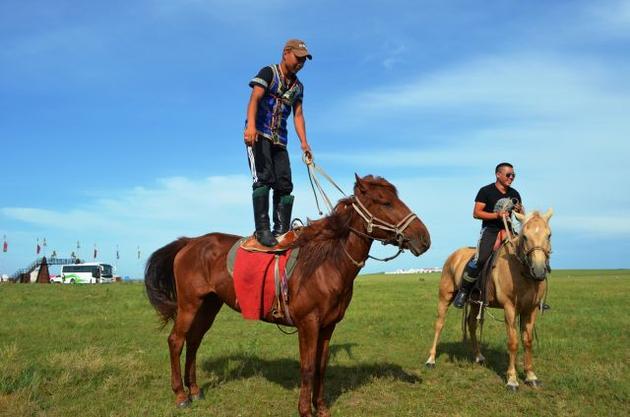|
The Hindu |
|
August 8, 2014 |
|
By
Ananth Krishnan |
|
 |
|
|
As a wave of
development transforms the Hulunbuir grasslands,
herders such as Tegexi (in picture) have the
chance to end their demanding nomadic lifestyles
for more stable livelihoods, but a difficult
challenge to hold on to their traditions. Photo:
Ananth Krishnan |
|
 |
|
|
A booming
tourism industry is bringing wealth to herders
in Inner Mongolia, but challenging the
ecosystem. Young Mongolians perform stunts on
horses for tourists. Photo: Ananth Krishnan |
|
Can Mongolian
traditions survive as China’s development transforms
grasslands?
When
Tegexi was growing up on the grasslands of Hulunbuir, a vast
plain that stretches between China, Mongolia and Russia,
there was never any doubt about what he would grow up to be.
For
more than 30 generations – ever since Genghis Khan swept
through this expansive grassland in China’s north – Tegexi’s
family has tended to cattle, sheep and horses, moving across
the grasslands in search of pastures between the bitterly
cold half year-long winters and the summer months.
Tegexi,
however, will be the last of his family’s herders. Herdsmen
in the town of Hailar, he says, are facing both
opportunities
and
challenges as a wave of development transforms the region:
the chance to end their demanding nomadic lifestyles for
more stable livelihoods, but a difficult challenge to hold
on to their traditions.
The
Chinese government's plans to boost already close trade
links to Russia are set to transform the Hulunbuir, which
extends across the Chinese “autonomous region” of Inner
Mongolia – a 25 million-strong home to ethnic Mongols,
bounded by Russia and Mongolia.
On
wide highways that zig-zag through the grasslands, trucks
laden with timber drive down from Manzhouli, a bustling town
on the Russian border, honking to avoid herds of sheep that
loiter on the roads.
Han
Chinese tourists are descending on Inner Mongolia’s
grasslands in huge numbers, bringing wealth to herders like
Tegexi but also, some locals fear, straining the grassland’s
resources. In some areas near the city of Ordos, conflicts
between Mongolian herders and Chinese mining companies
erupted in 2011.
Hulumbuir, Tegexi said in an interaction with journalists
organised by the government, presented a better model, where
the economy was driven by tourism and the dairy industry and
there was no mining.
At the
same time, he acknowledged the challenge faced in preserving
Mongolian culture – a battle faced by many of the 55 ethnic
minorities in a country where Han Chinese make up 90 per
cent of the population.
He
said there was a strong – even growing – sense of Mongolian
identity among the youth, who, even if fluent in both
Mandarin and the Mongolian language, still speak to each
other in their own tongue. “To the Chinese we speak in
Chinese,” he said, “but to each other we speak in
Mongolian.”
The
region faces a difficult balancing act in ensuring that the
rapid growth that the government is targeting can remain
sustainable. At the Manzhouli land port, the government is
spending millions in expanding the China-Russia trade zone
to a logistics park that will handle 70 million tonnes of
cargo annually, up from the current 30 million tonnes.
The
government is also pushing a transcontinental rail plan that
will run from Suzhou in southern China to Manzhouli and all
the way to Poland, through Russia. This will compete with a
second route being built from Chongqing in southwestern
China, through Xinjiang to Central Asia. “We believe this
route is four days shorter and cheaper by $ 1000 per
container,” says Li Xiguo, the deputy director of the port
affairs office.
The
development push comes as the government takes forward a
programme to resettle herdsmen and women and find
alternative employment for them. Under the current five-year
plan, the government will resettle as many as 1.16 million
people who live on 400 million hectares of grassland, before
next year.
The
programme has divided opinion among experts. Some say
overgrazing threatens the grasslands, so resettlement is
needed. But the plan may also mean the loss of livelihood
and traditions.
For
herders here, a booming dairy industry is one alternative
source of employment. A sprawling Nestle factory built on a
$ 500 million investment employs 5,573 local dairy farmers,
and is one of China’s biggest such plants, supplying milk
and dairy products to the whole country. The plant will, by
next year, double its capacity to 1,200 tonnes a day,
according to Zhang Zejun, a general manager, making up 15
per cent of the GDP of the local Erguna county.
“Because of this environment, dairy products from here have
a special reputation,” he said, pointing to rising concerns
about food safety in China where a spate of milk scandals
has dented confidence in many brands.
In the
Hulunbuir, way of life known for generations may soon come
to an end. Tegexi says his daily routine is not much
different from what his forefathers did 30 generations ago.
He rises at 4 am, tends to his 70 cattle, and takes his 600
sheep for grazing.
His
son (26) will return home, with a degree in computer
science, to start a business. His daughter (23) studies law
at a university in Hohhot, the regional capital.
“We
have had a nomadic life so I am happy if my son has a job in
the city,” he said. “We have had a nomadic life for
generations. But at the same time," he added, "I do not want
him to forget his traditions”.
|





